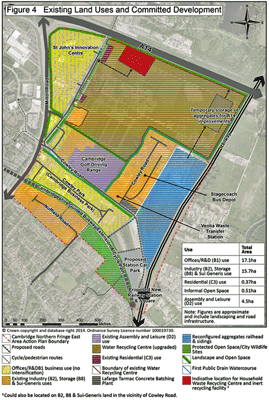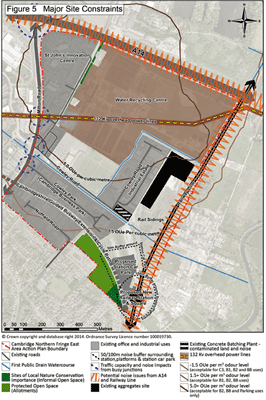Cambridge Northern Fringe East AAP - Issues and Options
6. SITE CONTEXT AND CONSTRAINTS
Introduction:
6.1 Before starting to plan for the future of CNFE, it is necessary to understand the area’s physical, social and economic characteristics. This chapter highlights the key constraints currently facing CNFE and the wider area that will need to be addressed by the AAP and future development proposals. (Make reference to the technical document for further detail).
6.2 The main key issues and challenges which have been identified as being specifically relevant to the CNFE AAP are listed below and are addressed within this chapter:
- Land uses and creating balanced communities;
- Movement/transport;
- Environment and open space;
- Built form and sustainable construction;
- Infrastructure.
Land Uses and creating balanced communities:
6.3 Mixed land uses and densities
- CNFE is currently a mixed use area with a predominance of employment uses including office, industrial uses, storage and minerals and waste activities (see Map of Existing Land Uses and Committed Development).
- Much of the land in the area is under-utilised in terms of development density. Where possible, opportunities should be found to accommodate existing occupiers, while rationalising and increasing the density of the area.
- Anglian Water’s Water Recycling Centre (WRC) occupies around 40% of the area, and is currently undergoing a £20 million upgrade to meet Cambridge’s planned growth needs to 2031.
- Neighbouring residential areas are home to some of the city’s more disadvantaged communities. This AAP and subsequent development proposals represent a significant opportunity to provide employment opportunities and other benefits to local residents.
- Consideration will need to be given to the wider context of CNFE, including changes expected to occur at Cambridge Science Park in the coming years.
- Cambridge is one of the UK’s five most competitive cities. Within CNFE, Cambridge Business Park and St John’s Innovation Park, along with the nearby Cambridge Science Park, comprise around 30% of the office and R&D stock in the urban area of Cambridge.
- CNFE is recognised as a strategic location for the provision of a range of employment development to enhance the economic potential of Greater Cambridge.
- There is a high level of housing need in the Cambridge area. While opportunities for housing on CNFE are limited, due to constraints such as odour and land contamination, the area can still make a valuable contribution to overall housing supply.
6.7 Community and Leisure Facilities
- CNFE currently has very limited facilities (e.g., retail, leisure and community uses) both within its boundary and in the surrounding area. The AAP and future development proposals offer an opportunity for provision of a new community core with shops, services, restaurants, cafés etc. with possible links to improved facilities on the Cambridge Science Park.
Movement/Transportation:
- The transport network in Cambridge is relatively constrained with finite capacity for vehicles. Access to the main part of the CNFE area is limited with just one main route in and out onto Milton Road. Capacity at this junction and along the Milton Road Corridor is a significant constraint. The Nuffield Road industrial area is separately accessed off Green End Road to the south.
- The AAP and subsequent development proposals provide an opportunity to maximise the sustainable transport opportunities offered by the proposed new railway station, the extension to the Guided Bus and connection to the existing high quality off-road cycle network alongside the existing Guided Busway, as well as enhancements to the network including the new Chisholm Trail.
- The aim should be to reduce the proportion of employed city residents who drive to work to 24% in order to keep traffic levels stable.
- Careful consideration needs to be given to appropriate levels of car parking provision for the site, with a potentially strong argument for strict parking standards given CNFE’s highly sustainable location.
- Permeability across the site is currently severely restricted due to physical barriers including the A14, the railway line and Milton Road. Increasing permeability is therefore crucial.
Environment and Open Space:
- Various contaminants are present on site, including heavy metals in soils, hydrocarbons in the soil and groundwater and chlorinated solvents. Elevated ground gases have also been identified on parts of the site. Further investigation and remediation will be required as part of any future development proposals.
- Anglian Water’s WRC serves Cambridge and a number of surrounding villages;
- The River Cam lies towards the east of the site, and the First Public Drain, which provides the surface water drainage for the whole of CNFE and the surrounding area, flows through the site. Both are potential sources of fluvial flooding, although the risk to the CNFE site is low.
- There is a risk of surface water (pluvial) flooding within CNFE, although this is confined to small areas. Development proposals will need to take this level of risk into consideration, providing mitigation through carefully designed sustainable drainage systems and other design measures.
- Levels of groundwater in the area are known to be high, although there are no recorded instances of groundwater flooding within CNFE.
- The WRC is a source of both odour and insects, which have an impact on the amenity of the surrounding area and the mix of uses that will be considered acceptable within CNFE. Odour zones, which will help inform the location of different uses on the site, have been mapped and are shown on following the Major Site Constraints plan.
- Areas immediately adjacent to the A14, the railway line and sidings, and the minerals and waste operations will be unsuitable for some forms of development due to noise issues. Other areas will require mitigation.
6.13 Other Environmental Impacts
- Consideration will need to be given to air quality associated with the industrial areas and adjacent major roads; dust from the minerals and waste operations; and vibration close to the railway line and sidings. Measures to reduce light pollution from new development will also be required.
6.14 Landscape, Ecology and Open Space
- It is important that major high density development is accompanied by landscaping and enhancements to the natural environment and this will be assessed through the development of the AAP. CNFE includes several areas of landscape which, along with their associated biodiversity, should be retained and enhanced, where possible.
- The area contains three notable areas of ecological value that will need to be protected and enhanced: Bramblefields Local Nature Reserve (LNR); the protected hedgerow on the east site of Cowley Road opposite St. John’s Innovation Centre, which is a City Wildlife Site; and the First Public Drain, which is a Wildlife Corridor.
- The CNFE area has very limited existing open spaces, and what open space exists, such as the Bramblefields LNR and Nuffield Road allotments, is utilised by the existing community. The neighbouring East Chesterton Ward has 2.89 hectares of mixed quality protected open space per 1,000 population, which compares poorly with the Council’s target of 4.1 hectares per 1,000 population. These deficiencies highlight the importance of open space provision within the CNFE site.
Built Form and Sustainable Construction:
- The scale of development at CNFE will be determined by a range of factors including demand, viability and transport constraints. Consideration will need to be given to the massing of development and its visual impact on the immediate and wider area, and this will be assessed through the development of the AAP. Scale and massing therefore needs to be appropriate for the area and its context.
- There is a need to maintain and where appropriate enhance
the overall character and qualities of the skyline of
Cambridge, as the city continues to grow and develop into the
future. Views and the wider landscape context will be
important considerations. Notwithstanding this, the CNFE area
is a significant distance from the historic core of the city
and within this context there may be an opportunity for the
development to include tall buildings depending upon
consideration of:
- consideration of location, setting and context;
- impact on the historic environment;
- scale, massing and architectural quality;
- impacts on amenity and microclimate;
- public realm; and
- any implications for Cambridge Airport’s Air Safeguarding Zones.
- Development at CNFE will need to complement and enhance the city’s character through the use of high quality design that maximises opportunities to support the natural environment with new and existing open spaces.
- The AAP will ensure that development proposals take a holistic approach to sustainable development, integrating the principles of sustainable design and construction into development proposals from the outset.
Infrastructure:
- The following infrastructure that provides important
services for Greater Cambridge will need to be taken into
account in the AAP and any future development proposals:
- The WRC;
- The Cambridge to Ely railway line on the eastern boundary of the site;
- The strategic aggregates railhead;
- The 132Kv overhead power line running east to west across the area.
- A network of underground cables and pipes that exists across CNFE is not considered to be a major constraint to development.
(27) Question 8
Do you have any comments on the Site Context and Constraints, and what other issues and constraints should be taken into account in the preparation of the Area Action Plan?


